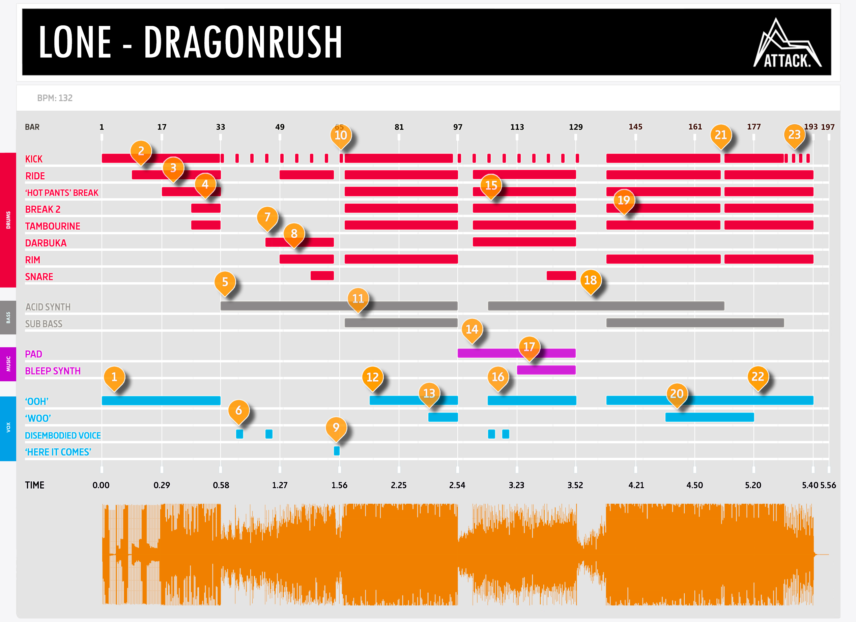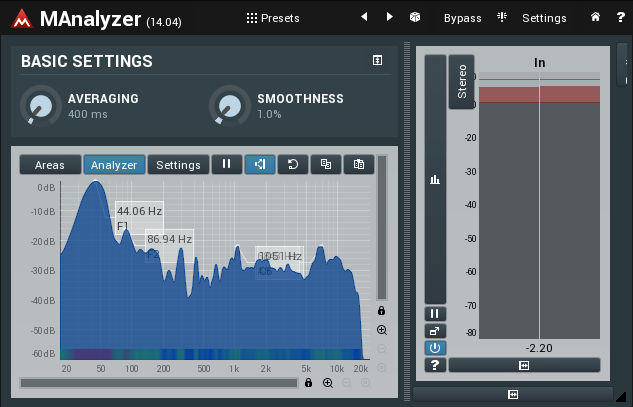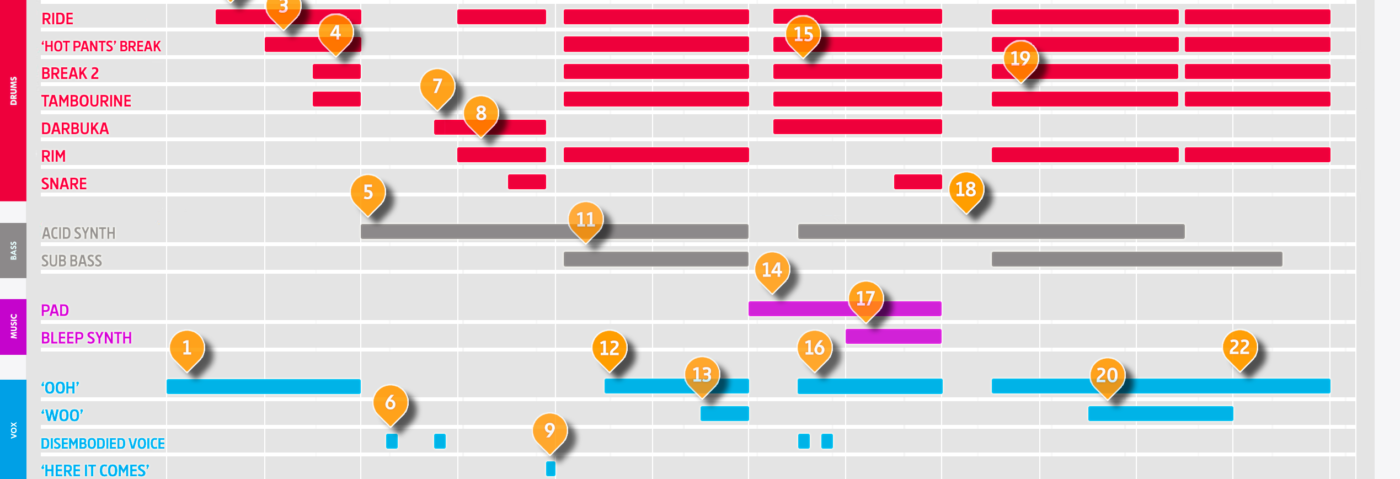Every month in Deconstructed we examine the arrangement of a successful dance track. This time, we tear down Lone’s throwback head rush of a tune, ‘Dragonrush’.
Where were you in ’92? If you’re old like us, probably in a field or dirty warehouse with a whistle around your neck and a handful of lollies in your pocket. We won’t wager as to where R&S artist Lone was in the heyday of raves but he clearly understands how to make a stomping hardcore choon. ‘Dragonrush’, one of the standouts on his split EP with Kettama, is pure 1992, from the twisting synth line and sub-bass drops to the hands in the air breakdown.
Lone is no stranger to the ‘90s sound. His career has been based on crafting exquisitely melodic paeans to the golden age of electronic dance music. From the swung house stylings of ‘Airglow Fires’ to the rollicking breakbeats of ‘Alpha Wheel’, Lone has mined a particularly rich vein of nostalgic bass music. ‘Dragonrush’ sees him taking this straight to the dance floor, and with devastating results.
Get your Vicks out and let’s rush.
The Track
The Arrangement

What’s Happening
1
We kick off at 132bpm with a bare, woody kick pounding out a four-to-the-floor beat. It’s not your typical, thuddy 909 kick—this one’s got more mids and it sounds like the highs have been rolled off. It comes off as a little odd on its own but it will make sense once the song gets fully underway. It’s accompanied by a male vocal sample, a trippy ‘ooh’ soaked in metallic reverb. As the reverb trails off, you can hear it pumping along, likely sidechained to the kick.
2
After eight bars, Lone adds some new percussion, with classic TR-909 rides striking on the offbeat. This kind of tried and tested intro lets us know what we’re in for: a bit of classic dance mania. It also keeps things DJ friendly. The kick and male vocal continue as in part 1.
3
Here Lone reveals the first of the cards in his hand: a break chopped up early ‘90s style. It’s hitting on the one of the beat rather than the two, accenting the kick. However, the way it bounces gives the beat a lift and groove typical of the genre. It’s hard to say precisely what break it is, but our money is on the Bobby Byrd ‘Hot Pants’ break, a super popular rhythm for early ‘90s hardcore.
4
After 16 bars, the chopped break is joined by a second one, adding a syncopated feel to the rhythm section. Note how the two breaks are panned slightly apart to give the track a bit of width. The unusual EQ curve on the kick now feels correct, sitting in with the breaks naturally. This kind of double break interplay was popularized by artists like Slipmatt and Lime of SL2, whose ‘Way In My Brain’ is a classic of the era.
Mixed slightly back in the mix is a tambourine programmed in 16th notes. This keeps the momentum driving forward and helps speed us up to the first breakdown. Notice also that the programming on the first break changes slightly at the end of its 16-bar section, creating a mini fill to lead us into the change.
5
At bar 33, the beat drops out. A dark reverb splash spills into the open space left by the loss of percussion but a snaking synth line is there to fill it. This is the driving force of ‘Dragonrush’, an acid-like pattern that’s definitely not a TB-303. It also twists and jumps in a very modern, DAW-programmed way. It’s classic Lone—looking back for inspiration but charging forward with new technology and production.
The filter cutoff on the synth line continues to open throughout the breakdown, increasing tension. Stereo delays add width to the synth line, filling out the sound field. A single kick drops on the first beat of each four-bar section, reminding us that the percussion section will come back soon.
6
Still in the breakdown, Lone continues to add elements to maintain the tension. A disembodied male voice that sounds like a preacher appears at bar 41 but tape echo smears his words into unintelligibility. We can almost make out what he’s saying but ultimately can’t, leaving us feeling confused.
7
At bar 44, a percussion roll ramps in and opens into a darbuka break on bar 45. Lone often uses non-Western percussion in his tracks for added rhythmic interest, and ‘Dragonrush’ is no exception. There’s a slight slap back echo on it to give it some space in the mix.
8
The breakdown continues to evolve. Now Lone brings back the off-beat rides and throws in 808-style rimshots, mostly panned to the right but with the occasional rogue rimshot jumping to the left. dance tunes need to be centre-focussed to sound good on club systems but there’s no harm in adding some stereo movement for home listeners. The rimshots will not return in the second breakdown.
9
The breakdown is still building with the opening synth, the lone kicks, the disembodied voice, the percussion. Into this comes a rolling 909 snare, fading in and doubling in speed in the classic techno style. It builds to bar 64—a bar sooner than expected—and suddenly cuts out in a flurry of dirty, metallic reverb. A vocal sample appears: ‘here it comes’, originally said by Master Ace in ‘Can’t Stop The Bumrush’ but made famous by DJ Seduction’s ‘Hardcore Heaven’.
10
Another feint. It didn’t come. Instead, Lone teases us with a single kick and cavernous reverb. Then, one bar late, he slams the beat back in. It’s a masterful double fake-out and it gives the drop that much more power.
11
The drop proper hits at bar 66. We’re now standing in the gale-force winds of ‘Dragonrush’, with synth line, percussion, and twin breaks at full force. He’s also unleashed the bass, a massive gut punch sub that fills out the lower end of the frequency spectrum.
‘Dragonrush’ was composed in the key of D minor. While many composers (including Nigel Tufnel) will tell you that D minor is a sad key, we suspect that Lone employed it for its low-end capabilities. Many dance music producers compose in A minor or D minor, largely because it helps the bass hit in the crucial 45-55Hz zone. A look at an analyzer reveals this to definitely be the case for ‘Dragonrush’.

12
At bar 73, Lone brings back the ‘ooh’ male vocal from the introduction. It’s pushed back in the mix, adding flavour rather than hogging attention. Some producers aim to make every element of a track crystal clear while others try to achieve a tonal whole. Lone has clearly gone for the latter approach here, with the song’s elements all contributing to the overall feeling. This is particularly noticeable in the percussion, which melds together into an unstoppable juggernaut.
13
The song cruises along, its synth line snaking and burbling, until bar 89, where Lone drops another ’92 hardcore trope: the ‘woo’ sample. While it’s hard to pinpoint it, it could very well have been sourced from Iggy Pop’s tone-deaf ‘African Man’. This is the source of the classic rave ‘woo’ as used in Praga Khan’s ‘Injected With A Poison’ and Westbam’s ‘Monkey See, Monkey Do’. The sample does what it’s supposed to: it squirts a hit of nitrous oxide into the song’s engine and accelerates it to the middle breakdown.
14
The breakdown arrives at bar 97 and it’s classic Lone. As a lingering kick and ride fade out, Lone clears out all the instrumentation to put the focus on a gorgeous polysynth chord progression. It’s an instant hands in the air moment and could have you crying if you’re not careful.
15
At the end of two bars, the darbuka roll back in. They play their usual pattern, as do the two duelling breakbeats. The 909 ride keeps offbeat time. The occasional solo kick provides weight. The chord progression continues, its emotive content a nice contrast to the rushing percussion.
16
At bar 105, both the male ‘ooh’ and the disembodied voice drop, adding a touch of confusion to the proceedings. The synth line returns as well and starts its ascent, with the filter cutoff slowly opening and closing throughout the breakdown.
17
Next to arrive is a high, sharp synth melody. It wouldn’t be a Lone track without a bleep-style melody with lots of portamento. Think early ‘90s LFO and other classics from the early days of Warp Records. It fades in, its cutoff filter opening until it’s almost washed completely out. Increasing delay gives it a spacey vibe. The snare roll is the last to appear, perhaps a duplication of the pattern from the first breakdown.
18
Another fake-out. At bar 129, Lone again teases us with a drop to just the synth line, its filter now closed down to only low frequencies. Reverbed echoes of the breakdown ripple out for almost two bars, likely the result of automation opening just before bar 129. The synth line continues to open up across eight bars.
19
With no warning, Lone slams the full beat and bass back in at bar 137. Now we’ve got the kick, rides, tambourines, double breaks, and sub-bass full in our faces. The synth line twists and turns while the male voice punctuates the beat. This continues for 16 bars.
20
As with part 13, Lone brings back the ‘woo’ sample to make sure that energy stays high.
21
At bar 168, Lone drops the beat for a moment to signify that the song will change and move into the ending portion of the song. ‘Dragonrush’ is fairly unusual in that it doesn’t have many of these transition sections. There are very few drum fills to speak of. The overriding momentum of the song is enough to keep things moving forward.
22
From bars 169 to 185, the beat continues apace with the sub-bass holding everything down. The ‘ooh’ vocal is still doing its thing but the snaking synth line has disappeared. It’s time for the DJ to start bringing in the next track.
23
Here, at last, is the outro. While the kick and bass have dropped away, the percussion stays full—rides, tambourine, breaks—as if the song is reluctant to stop moving. But stop it must, and it ends at bar 193, with a last exhalation of reverb to trail into silence.
